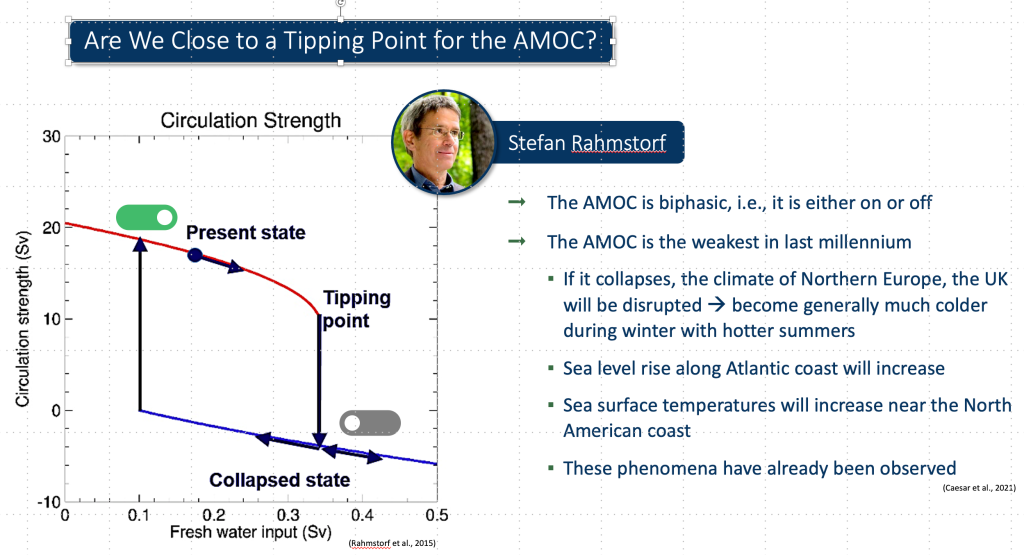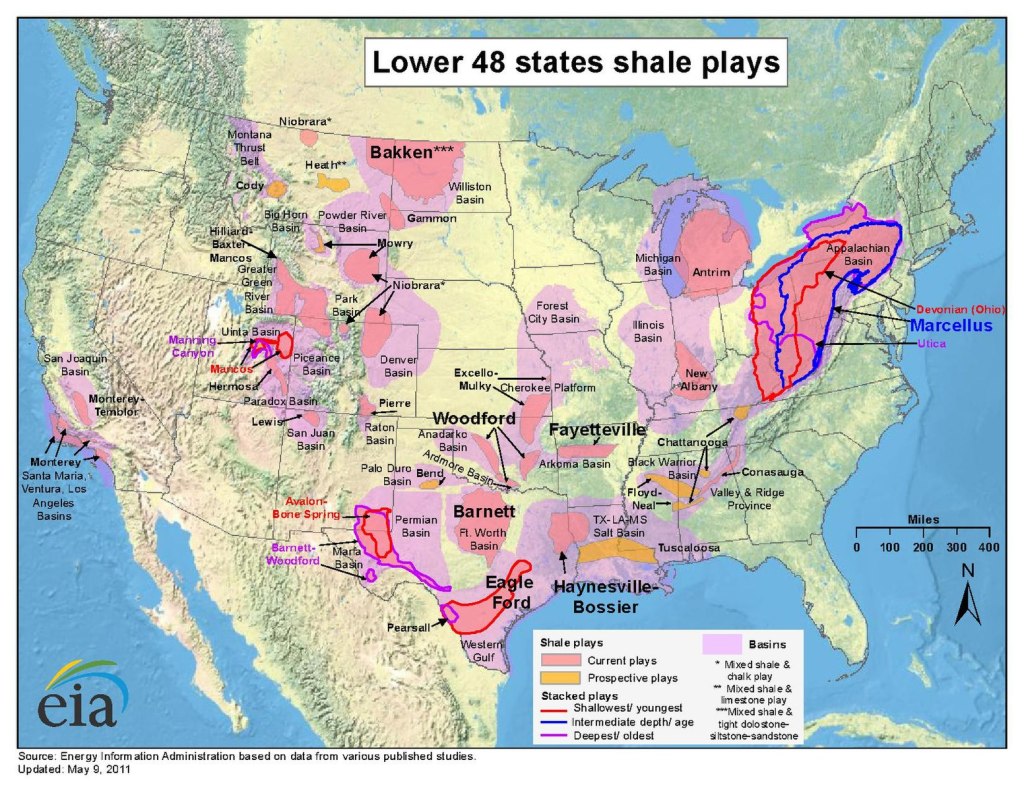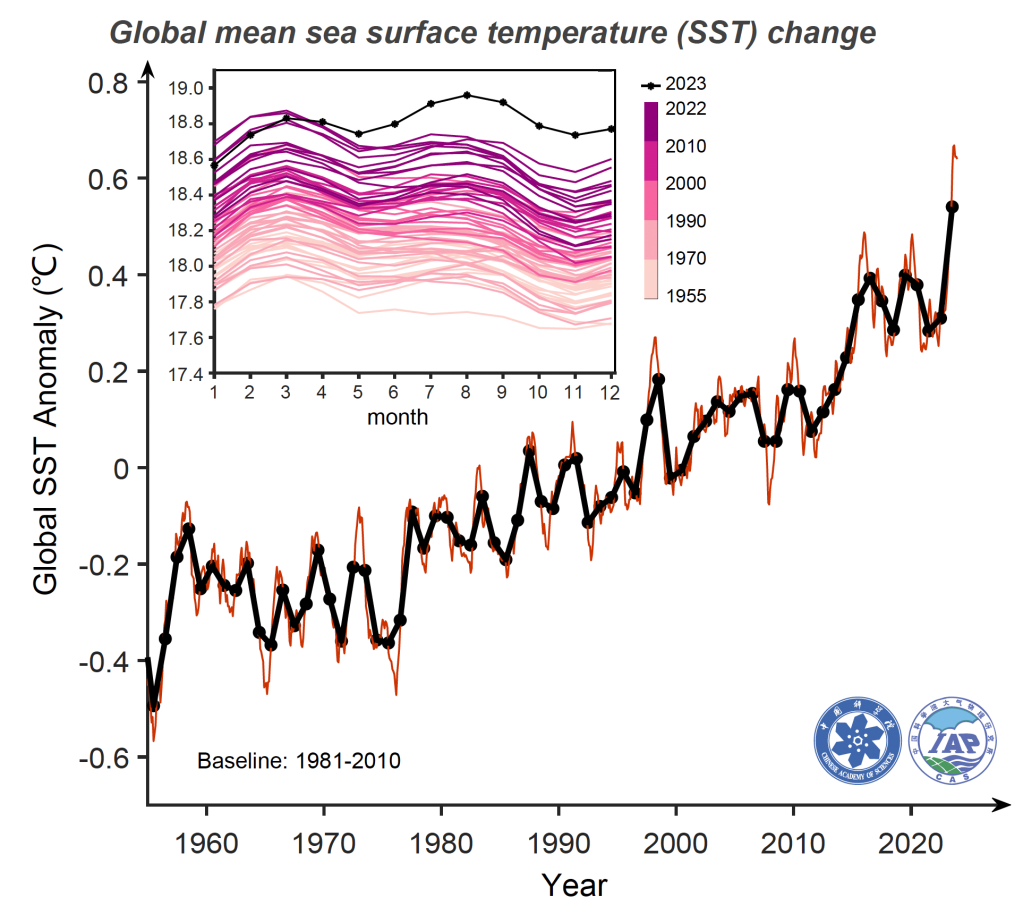Updates from the news #02 – 15 February 2024
CO2 concentration at NOAA Mauna Loa Observatory 13 February 2024 – 424.20 ppm (one year ago – 421.18 ppm). Reminder: the safe level is 350 ppm.
Latest monthly CH4 mean – October 2023 – 1933.46 ppb (October 2022 – 1920.16 ppb). The global annual increase is shown in this graph. Note that the bars represent the increase, not the absolute amount, which is shown in the second graph. Methane stays in the atmosphere on average about 12 years.


A recent study published in Science Advances has received front-page coverage in the environmental press and media. It shows that the Atlantic Meridional Overturning Circulation (AMOC) is advancing toward a tipping point due to massive freshwater additions from rivers and the melting of glaciers in Greenland. If the AMOC transitions abruptly it would cause catastrophic changes in global climate, shifting rainfall patterns and causing extreme cold during winter in regions of the North Atlantic. The UK and EU would be especially hard hit and the wet and dry seasons in the Amazon could reverse. The ongoing freshwater additions are progressively stalling deep water formation in the polar region of the Atlantic, especially off the southern coast of Greenland.


The Biden Administration pause on LNG development is not what it appears to be. Although the Republicans have spun this as an outrageous transgression of the free market, the environmental Left is also exaggerating the importance of this decision. Emily Atkins explains on Heatmap. The Biden Administration did not block the export of LNG to other countries, nor did this executive order pause the ongoing construction of new LNG export facilities. It only blocks the construction of new LNG facilities. Massive ongoing LNG exports will continue. The IEA reports that shale gas production in the US has peaked, and thus expanding this capacity may not be the best business choice.
Here is a map of the regions of the US where massive shale gas production has been underway. The US is the largest producer of fossil fuels in the world.

Because of the extreme coral heat stress in 2023 NOAA Coral Reef Watch has extended the alert scale, creating five levels rather than the previous standard of two levels.
At the height of last year’s bleaching event, large portions of the Pacific and Atlantic were engulfed in a Level 2 alert (red areas) using the previous alert scale. Note that the area around Florida was not as severe as the extreme warming in the Caribbean and the Atlantic exending to West Africa. The current daily alert status can be found here.

Through January 2024, for the first time the world experienced 12 months with warming level above 1.5˚C.
Up to 47% of the Amazon rainforest may transition to a new state by the year 2050. Many of us who have worked in this forest have been fearful that much of this forest will be lost during the coming decades. Although healthy old-growth rainforest is a carbon sink, the transition of large parts of the Amazon would result in massive loss of carbon to the atmosphere, amplifying global warming. The schematic here shows the drivers of water stress and likely alternative ecosystem states.

The ongoing devastating drought in the Amazon River Basin has been mostly driven by human-caused climate change, not the ongoing El Niño in the Pacific. While the El Niño has teleconnections to extreme weather in many regions, World Weather Attribution has shown that climate change is the main driver of this drought. The map below shows the 6-month drought classification for June-November 2023.

Newly discovered documents have shown that a coalition of oil and car manufacturing interests funded Charles Keeling’s famous work measuring atmospheric CO2 at the Mauna Loa Observatory in 1954. The coalition was known as the Air Pollution Foundation. Experts at the Climate Investigations Center say that the documents show the fossil fuel industry had a major role in the inception of modern climate science, but publicly denied this science for decades.
Coastal regions of Chile have suffered devastating wildfires while most of South America shows extreme soil drought. This condition of the soil promotes wildfires and grazing and crop failures.

Electric vehicles are far more efficient than gasoline powered vehicles. The detail of energy transfer from fuel to the wheels is shown in the two figures below.


Because of the corruption and failure of the UN COP conferences, which are now increasingly controlled by fossil fuel interests, activists are turning more toward local actions. Legal challenges to institutions and governments are on the rise, and 2024 promises to see an acceleration of legal actions. At UF, a coalitions of student organizations led by Sunrise Movement GNV have created a manifesto and petition drive to move the University of Florida to take more focused action on climate change. You can find out more about Green New Deal UF and sign the petition here.
The Planetary Health Report Card, founded in 2019, is a metric-based tool for evaluating and improving planetary health content in health professional schools. Presently more than 95 medical schools in 10 countries have been evaluated. The UF College of Medicine has little or no instruction in global change impacts on family and public health.
The oceans are hotter than ever since the previous interglacial, and quite probably for as long as since the Pliocene, about 3 million years ago. The consequences are unfolding through cyclones and failing fisheries and widespread coral death. 2023 was the most extreme warming on record.

As reported by Inside Climate News, groundwater levels around the world are decreasing at an accelerating rate. The draining of ancient groundwater for crop irrigation has resulted in critical water deficiencies in major crop producing regions. The implications of this for future food security are obvious.

AND FINALLY THIS JUST IN – SACHI KITAJIMA MULKEY HAS BEEN NAMED A 2024 GRIST FELLOW. This is a BFD in the world of environmental journalism.

You must be logged in to post a comment.